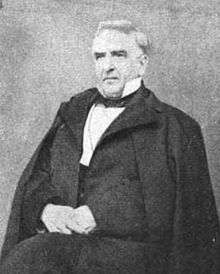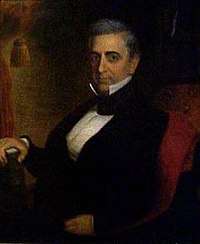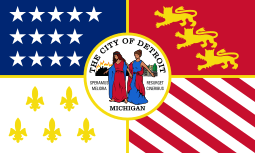Zina Pitcher
Zina Pitcher (April 12, 1797 in Sandy Hill, New York – April 5, 1872 in Detroit) was an American physician, politician, educator, and academic administrator. He was a president of the American Medical Association, a two-time mayor of Detroit and a member of the Board of Regents of the University of Michigan.[1]
Zina Pitcher | |
|---|---|
 | |
| 18th Mayor of Detroit | |
| In office 1843–1843 | |
| Preceded by | Douglass Houghton |
| Succeeded by | John R. Williams |
| 16th Mayor of Detroit | |
| In office 1840–1841 | |
| Preceded by | De Garmo Jones |
| Succeeded by | Douglass Houghton |
| Personal details | |
| Born | April 12, 1797 Sandy Hill, New York |
| Died | April 5, 1872 (aged 74) Detroit, Michigan |
| Alma mater | Middlebury College |
| Profession | Physician |

Biography
Early life
Dr. Zina Pitcher was born in Sandy Hill, New York on April 12, 1797. He was the son of Nathaniel Pitcher Sr., who died in Sandy Hill, N.Y., 1802, and Margaret Stevenson, who died in Kingsbury, N.Y., in 1819. He was the younger half-brother of Nathaniel Pitcher, a future Governor of New York. (In his 1836 will, Nathaniel mentioned an Osage orange walking stick given to him by Zina.) Another of Zina's brothers was James Pitcher, who became the first mayor of the city of Little Rock, Arkansas, in 1835. Zina attended Middlebury College in Vermont and graduated in medicine in 1822.
Career
Pitcher joined the Army in 1822 as an assistant surgeon, and was promoted to the rank of major in 1836 as a full surgeon. He was president of the Army Medical Board in 1835, and resigned from the Army at the end of 1836.[2]
Pitcher was also an excellent botanist (not uncommon for medical professionals of his day). He collected and studied plants in the Great Lakes region, and the exceedingly rare Pitcher's thistle (Cirsium pitcheri) was first collected by him from the Grand Sable Dunes during his service as an Army surgeon; subsequently it was named for him as well.[3] At times Pitcher teamed with botanist Thomas Nuttall.[4]
He moved to Detroit, and was elected mayor for two separate terms, once from 1840–1841 and again in 1843. He was also a regent of the University of Michigan from 1837 until 1852. He served as president of the American Medical Association from 1856–1857, presiding over its annual meeting in Detroit.[2]
He died in Detroit on April 5, 1872 and is buried in Elmwood Cemetery.[5]
Commemoration
- The Zina Pitcher Collegiate Professorship of the History of Medicine at the University of Michigan Medical School
- Zina Pitcher Place, a street leading into the University of Michigan Medical Center
- The Great Lakes endemic plant, Pitcher's thistle, named for its discoverer.
Notes
-

- Wilson & Fiske 1888, p. 31
- Bill Collins (August 2004). "Dr. Zina Pitcher — Bandages, Beaches, Botany, and Ballots". Huron Ecologic. Retrieved January 27, 2012.
- "Nuttall, Thomas & Pitcher, Z." Index of Botanists. Harvard University Herbarium. Retrieved January 27, 2012.
- Franck 1996, p. 42
- IPNI. Pitcher.
References
- Franck, Michael S. (1996), Elmwood Endures: History of a Detroit Cemetery, Detroit: Wayne State University, ISBN 0-8143-2591-2
- Wilson, James G.; Fiske, John (1888), Appletons' Cyclopædia of American Biography, p. 31
External links
| Political offices | ||
|---|---|---|
| Preceded by De Garmo Jones |
Mayor of Detroit 1840–1841 |
Succeeded by Douglass Houghton |
| Preceded by Douglass Houghton |
Mayor of Detroit 1843 |
Succeeded by John R. Williams |
| Party political offices | ||
| Preceded by Philo C. Fuller |
Whig nominee for Governor of Michigan 1843 |
Succeeded by Stephen Vickery |
| Business positions | ||
| Preceded by George B. Wood |
President of the American Medical Association 1856–1857 |
Succeeded by Paul F. Eve |
